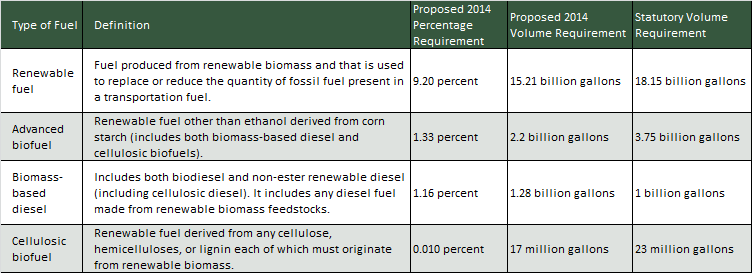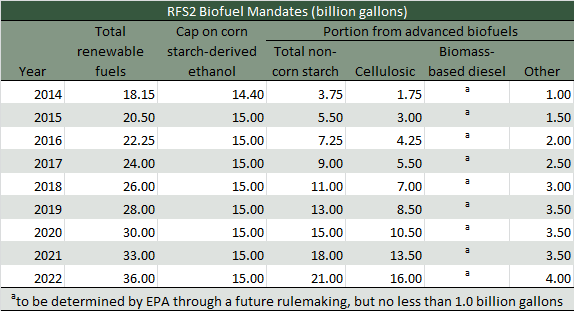3 min read
EPA to Announce 2014-2016 Renewable Fuel Standard in Spring 2015
 Suz-Anne Kinney
:
March 31, 2015
Suz-Anne Kinney
:
March 31, 2015

Recent actions by the Environmental Protection Agency (EPA) and petrochemical industry organizations suggest that 2015 will be another controversial year for the Renewable Fuel Standard. The 2014 volume requirements have yet to be finalized, multiple proposals have been floating in Congress (one bolstering biomass-based diesel, another removing the corn-based ethanol requirement) and at least one lawsuit has been filed.
2014 Volume Requirements
In November 2013, EPA proposed 2014 volume requirements that were lower than expected. As proposed, the standards would require refineries to produce 9.2 percent of their output from renewable sources in 2014, 1.33 percent of that from advanced biofuels. Translated into volume requirements, that equals 15.21 billion gallons of renewable fuel, 2.2 billion from advanced biofuels and the remaining 13.01 from corn-based ethanol.

Sixteen months later, EPA has yet to announce the final standard. According to the Energy Independence and Security Act (EISA), the legislation that created the RFS, EPA is supposed to issue final requirements not later than November 30 of the previous year (in this case, the same date on which the proposed requirement was announced). Why the delay?
The requirements, as proposed, set off a firestorm of controversy. Mike McAdams, President of the Advanced Biofuels Association noted that the proposed Advanced Biofuels target of 2.2 billion gallons would “pull the rug out from underneath the growing advanced biofuels industry.” Brooke Coleman, Executive Director of the Advanced Ethanol Council went so far as to suggest that EPA was doing the bidding of oil companies: “What we’re seeing is the oil industry taking one last run at trying to convince administrators of the RFS to relieve the legal obligation on them to blend more biofuel based on clever arguments meant to disguise the fact that oil companies just don’t want to blend more biofuel.”
In its own defense, EPA argues that the standards need to be reduced because we are approaching the blend wall (the point at which it is difficult to incorporate ethanol into the transportation fuel supply, currently 10 percent) at a time when overall gasoline consumption has been dropping in the U.S. As a result, EPA argues, we need less ethanol than legislators anticipated in 2007 when EISA was enacted.
This argument was not well received by the biofuels industry, however; industry groups and producers found fault with EPA’s use of gasoline consumption levels to set the target, arguing that Congress fully understood the E10 blend wall issue when it enacted the legislation. Congress passed the bill in part to require the petroleum industry to distribute renewable fuels. The gradually increasing volume requirements laid out in EISA were intended to give the oil industry ample time to make the infrastructure changes necessary to increase the blend wall.
When Will the Standards for 2014 Be Set?
The petroleum industry is also unhappy with the delay. The American Fuel and Petrochemical Manuafacturers (AFPM) and the America Petroleum Industry (APS) have filed a lawsuit against EPA for ignoring its duty to set blending requirements. A proposed consent decree in this case calls for the following schedule:
- 2014 and 2015 standards will be proposed by June 1 and finalized by November 30.
- Though outside the scope of the decree, EPA has said it will propose and finalize the 2016 and 2017 standards according to the same schedule.
It should be noted that the decree is not yet final, as law requires EPA to provide reasonable opportunity for parties to comment on the proposed decree, consider comments and then sign the decree only if "none of the comments disclose facts or considerations which indicate that the decree is inappropriate, improper, inadequate, or inconsistent with the Clean Air Act’s requirements."
The delay will continue to be a point of contention between the conventional and renewable fuels industries, since the failure of EPA to develop a final rule creates uncertainty, and uncertainty discourages investment. KiOR is just one example of the funding difficulties that renewable fuels producers faced in the uncertain regulatory environment in 2014.
Where Will the Final Numbers Fall?
In addition to announcing a time frame for the release of the 2014-2016 standards, EPA also began setting expectations for the final 2014 numbers. According to Christopher Grundler, a director at EPA’s Office of Air Quality and Transportation, the numbers will be based on actual production numbers, which totaled 17 billion gallons in 2014, 14.3 billion of which was corn-based ethanol. That will leave 2.7 billion gallons for the advanced biofuels sectors.
What will the requirements be for 2015 and 2016? We’ll find out by the end of spring, which—Grundler reminds us—is “midnight, June 21, 2015.” The following table shows the statutory requirements.

Regardless of where the numbers fall, 2015 will certainly be another controversy-filled year for biofuels. EPA’s decision to propose 2015 and 2016 standards before the end of June suggests that they might meet the November 2015 deadline for announcing the 2016 blending requirements. As a result, 2016 might be the year EPA regains control and gets the RFS back on track.





